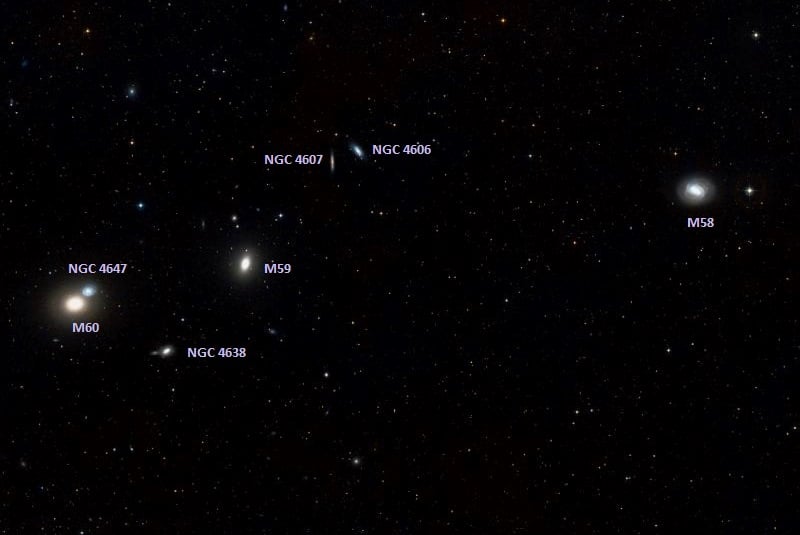Welcome back to Messier Monday! Today, we continue in our tribute to our dear friend, Tammy Plotner, by looking at the spiral galaxy known as Messier 59.
In the 18th century, while searching the night sky for comets, French astronomer Charles Messier kept noting the presence of fixed, diffuse objects he initially mistook for comets. In time, he would come to compile a list of approximately 100 of these objects, hoping to prevent other astronomers from making the same mistake. This list – known as the
Messier Catalog
– would go on to become one of the most influential catalogs of Deep Sky Objects.
One of these objects is the elliptical galaxy known as Messier 59 (aka. NGC 4621). This galaxy is located approximately 60 million light-years from Earth in the direction of the southern Virgo constellation. Sitting just a few degrees away Messier 60, and bordered at a distance by Messier 58, this galaxy is visible using smaller instruments, but is best observed using a larger telescope.
[caption id="attachment_36333" align="aligncenter" width="443"]
Atlas image of Messier 59 obtained by the Two micron All Sky Survey (2MASS). Credit: 2MASS/NASA/UMass
[/caption]
Description:
Located about 60 million light years away and spanning about 90 million light years of space, but what exactly is its type? Says Takao Mizuno (et al) in their
1996 study
:
What could account for such unusual behavior? Try a quiet black hole! As J. M. Wrobel (et al) indicated in their
2008 study
:
[caption id="attachment_1776" align="aligncenter" width="950"]
The M59 spiral galaxy. Credit: NOAO
[/caption]
History of Observation:
Both M59 and neighboring M60 were discovered on April 11, 1779 by Johann Gottfried Koehler who wrote: "Two very small nebulae, hardly visible in a 3-foot telescope: The one above the other." Charles Messier would independently recover it four days later and state in his notes:
While both William and John Herschel would also observe it, it sometimes confounds me that they didn't seem to notice all the other galaxies around it! Fortunately for historic record, Admiral Smyth did:
Locating Messier 58:
M59 is a telescope-only object and requires patience to find. Because the Virgo Galaxy field contains so many galaxies which can easily be misidentified, it is sometimes easier to "hop" from one galaxy to the next. In this case, we need to start by locating bright Vindemiatrix (Epsilon Virginis) almost due east of Denebola. Then starhop four and a half degrees west and a shade north of Epsilon to locate one of the largest elliptical galaxies presently known - M60.
[caption id="attachment_137520" align="aligncenter" width="580"]
The location of M59, which sits between M58 and M60 in the direction of the Virgo constellation. Credit: IAU
[/caption]
At a little brighter than magnitude 9, this galaxy could be spotted with binoculars, but stick with your telescope. In the same low power field (depending on aperture size) you may also note faint NGC 4647 which only appears to be interacting with M60. Also in the field to the west (the direction of drift) is the Messier we're looking for, bright cored elliptical galaxy M59.
In a smaller telescope, do not expect to see much. What will appear at low power is a tiny egg-shaped patch of contrast change with a brighter center. As aperture increases, a sharper nucleus will begin to appear as you move into the 4-6" size range at dark sky locations, but elliptical galaxies do not show details. As with all galaxies, dark skies are a must!
Enjoy your journey around the Virgo Galaxy Field!
- Object Name
-
Messier 59
- Alternative Designations
-
M59, NGC 4621
- Object Type
-
E5 Galaxy
- Constellation
-
Virgo
- Right Ascension
-
12 : 42.0 (h:m)
- Declination
-
+11 : 39 (deg:m)
- Distance
-
60000 (kly)
- Visual Brightness
-
9.6 (mag)
- Apparent Dimension
-
5x3.5 (arc min)
We have written many interesting articles about Messier Objects here at Universe Today. Here's Tammy Plotner's
Introduction to the Messier Objects
,
M1 – The Crab Nebula
, and David Dickison's articles on the
2013
and
2014
Messier Marathons.
Be to sure to check out our complete
Messier Catalog
. And for more information, check out the
SEDS Messier Database
.
Sources:
- *Constellation Guide - Messier 59*
- *SEDS - Messier 59*
- Wikipedia - Messier 59
 Universe Today
Universe Today
